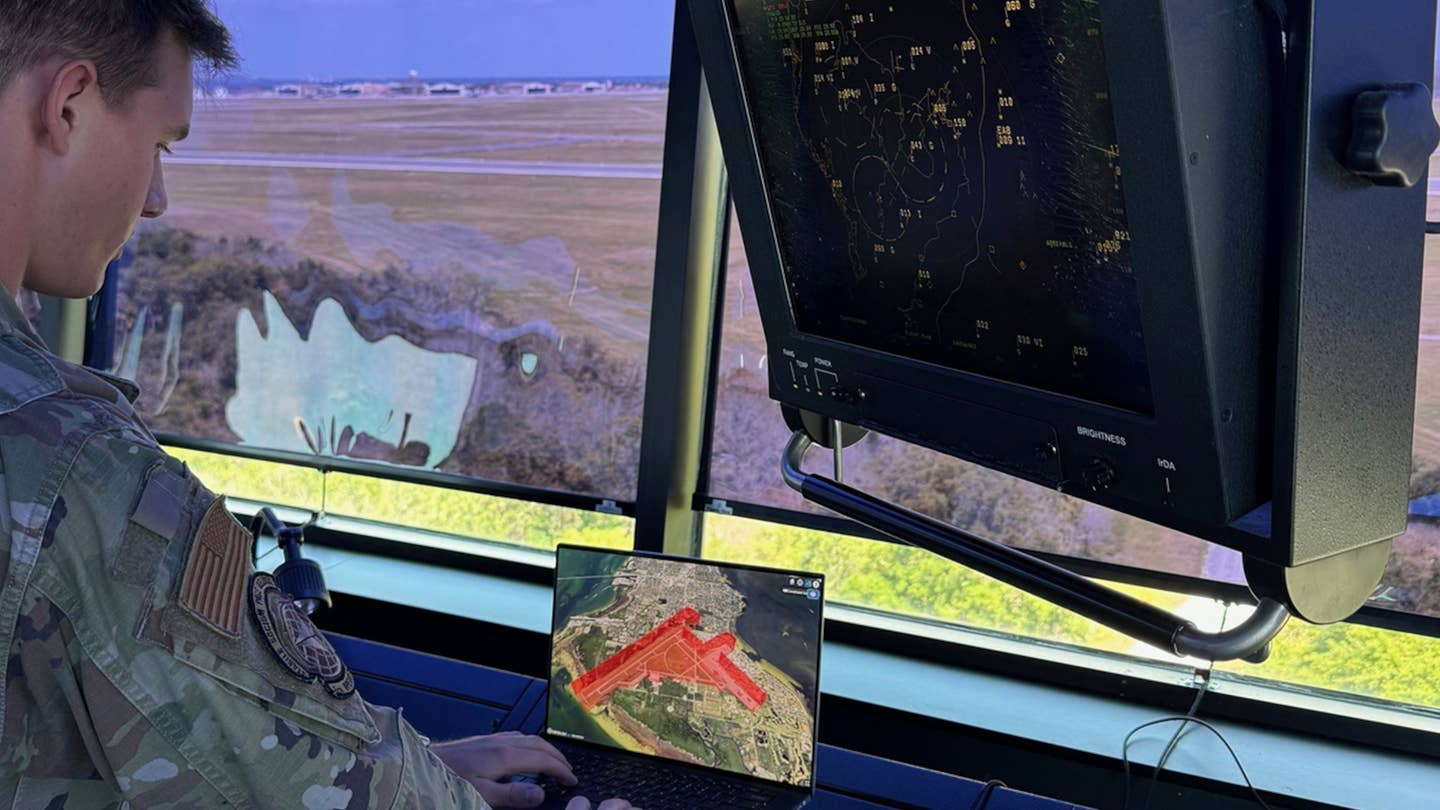Air Force Begins Testing Uncrewed Aircraft Traffic Control System
The Air Force Research Laboratory is studying ways to integrate flights of uncrewed aircraft systems (UAS) at bases nationwide.

Senior Airman Brooks Dingman, an air traffic controller for MacDill AFB’s 6th Operations Group in Florida, uses CLUE to designate areas requiring approval for drone flight. [Courtesy: U.S. Air Force]
The U.S. Air Force is looking to fly more drones and other uncrewed aircraft systems (UAS) at bases across the country.
On Monday, the Air Force Research Laboratory (AFRL) announced that it and the Air Mobility Command (AMC), which provides aerial refueling and airlift services for U.S. forces worldwide, began testing a UAS traffic management (UTM) system at MacDill Air Force Base in Florida.
The system, called CLUE, or Collaborative Low-Altitude Unmanned Aircraft System Integration Effort, is designed to integrate UAS flights next to crewed aircraft above and around Air Force installations. According to the AFRL, MacDill is the first base to use a UTM system in airspace overseen by Department of Defense air traffic controllers.
“This is a significant milestone for AMC, AFRL, and the CLUE program, as the MacDill Air Traffic Control Tower and Base Defense Operations Center are first in the Air Force to operationally assess UTM capabilities,” said Phil Zaleski, manager of the AFRL CLUE program.
CLUE was born out of the AFRL’s Information Directorate as a project meant to provide “air domain awareness, situational awareness, and UTM operational capabilities for UAS operators, air traffic control [ATC] personnel, Security Forces and other stakeholders.”
The system arrived at MacDill in 2022, where initial testing focused on airspace deconfliction, communication, and security. The goal was to enable drone flights beyond the visual line of sight (BVLOS) of the operator, which are heavily scrutinized and restricted by the FAA.
Since then, the UTM platform has been developed to give air traffic controllers a three-dimensional view of UAS activity and make it possible to grant flight permissions automatically.
“Equipping airspace managers and UAS operators with a 3D operational viewing capability and additional features designed to reduce lengthy manual and advanced planning procedures will be critical to achieving real-time flight planning and mission execution,” said James Layton, chief of plans and programs at MacDill.
The system is also sensor-agnostic, meaning it integrates with an array of different sensors designed to detect, track, and identify drones, including a counter UAS system being tested at MacDill.
The Air Force in May began formally testing CLUE’s capabilities on the base, opening it to the site’s ATC tower, Defense Operations Center, and airfield management team. Personnel so far have used the system to plan the intent of UAS flights or let operators know where they are approved to fly a drone, for example.
Operators ask CLUE for the all clear to fly, and their request is either approved or denied by the control tower. Once permission is granted, they can fly within a bounded area. CLUE feeds the operators information about the airspace and other nearby aircraft, helping them stay within the approved zone while avoiding other drones.
The UTM system has also been installed at Eglin AFB’s Duke Field (KEGI) in Florida, where the AFRL conducted a demonstration of its capabilities in 2023. There, CLUE will begin by integrating flights of small UAS (weighing less than 70 pounds) before moving to larger designs, including electric vertical takeoff and landing (eVTOL) air taxis such as Joby Aviation’s five-seat S4.
Joby, partnering with AFWERX, the Air Force’s innovation arm, earlier this year committed to deliver two air taxis to MacDill and has also shipped a prototype aircraft to Edwards AFB in California.
MacDill in May also hosted flights of a KC-135 Stratotanker equipped with an autonomous flight system from developer Merlin Labs, which is designed to one day enable fully remote flights. That technology, as well as systems from fellow AFWERX collaborators Xwing and Reliable Robotics, could one day be integrated into the CLUE UTM.
AFWERX and the AFRL are not the only government entities studying UTM systems. The Air Force is working with NASA to build a digital operations center for drones and electric air taxis nationwide and is collaborating with the FAA to integrate novel and uncrewed aircraft with air traffic control and other systems within the national airspace.
Like this story? We think you'll also like the Future of FLYING newsletter sent every Thursday afternoon. Sign up now.

Subscribe to Our Newsletter
Get the latest FLYING stories delivered directly to your inbox






